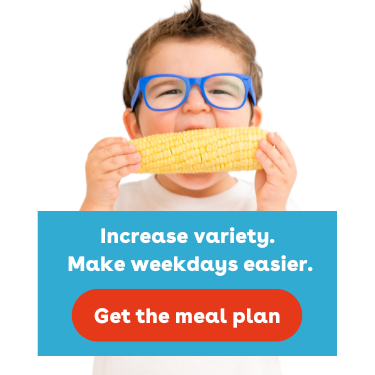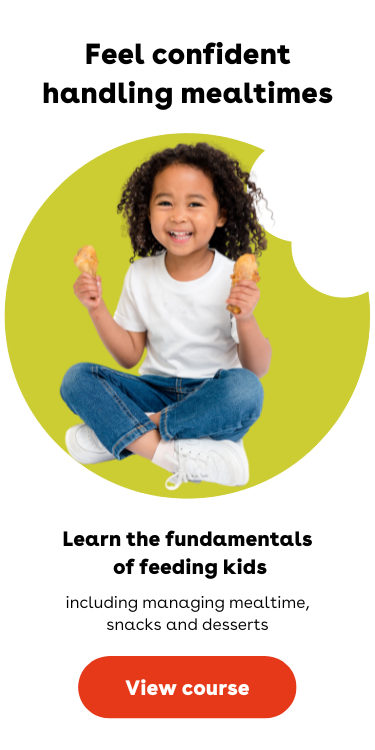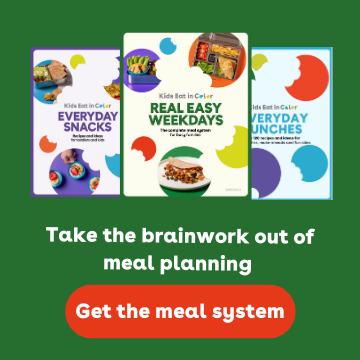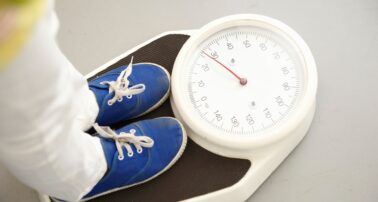I’ll never forget standing in the pediatrician’s office looking at the growth chart. It had a flat line on it! What? But I’m a dietitian! And my kid eats a healthy diet!
The pediatrician had been on our case since my son was 6-months-old. We were even pouring cream in milk to add calories. It’s hard when you have a child who is super active and also super not into eating. We thought “what are some high calorie foods for toddlers that they’ll ACTUALLY eat??”
I know you may have been there.
We talked to several pediatricians to see if it would be appropriate to test him for common causes of growth issues (there are others too, but all need to be discussed with a healthcare provider):
All those came back negative.
I also did a calorie analysis of everything my child was eating. I am, after all, a registered dietitian. And I learned that he needed more calories. He loved vegetables and fruit (the lowest calorie foods) so I needed to find ways to bring in more high calorie foods!
I made it my full-time job (on the side of my other full-time job) to make calorie-dense foods. I added calories to everything that he ate during his eating routine.
Related: The Most Overlooked Reason Your Child Is Not Eating Food
High-calorie foods for kids
Calorie boosters are things you can add to food. You can even add them to naturally high-calorie foods for toddlers!
After implementing this lifestyle for 3 months, we went to our “height check” appointment with the pediatrician. Guess what? Our little guy had maintained his curve!
Remember, a low percentile isn’t bad. Healthy kids come in all percentiles. Most kids stay around their percentiles over time. It’s only if the child is quickly or dramatically changing percentiles that we stop and consider. The goal is to maintain your child’s genetic percentile. It’s not healthy to try to feed a child extra calories in hopes that they will somehow increase their percentiles or because you think they are too thin. A healthcare provider will let you know if your kid is struggling with growth.
1. Avocado Oil
Avocado oil is one of my favorite high calorie foods for children. It is relatively flavorless, so it blends into almost any food. I add a little pour of it to everything from oatmeal, soup, bread (under the butter), yogurt, and anything else I can think of. I just leave it on my counter we use it so fast.
It’s also great for cooking.
If a recipe called for applesauce in muffins, I use avocado oil instead. I take a low-calorie recipe and make it a high calorie recipe using avocado oil.
Additionally, I add it to his smoothies. He’s not much of a smoothie guy though. He went for peanut butter, milk, and banana “milkshakes,” however, and I add a bit of avocado oil to that.
Related: How to Help Your Child Learn to Eat Avocado
2. Grass-Fed Butter
I’m not really on the “anti-butter” train. In fact, I frequently would cut butter slabs into shapes and put them in his preschool lunches! Butter is available all the time for my children. It is a great tool for adding flavor and is a high calorie food for toddlers.
I consider grass-fed butter when I can. Grass-fed butter is butter made from milk of cow’s who primarily eat grass.
Conventional cow’s milk in the U.S. can have a high ratio of omega-6 to omega-3 fatty acids. We get a lot of omega-6s in our diets in the United States and it leads to inflammation among other things. Many people need more omega-3s in their diet to balance out the omega-6s.
Grass-fed cows make milk that has a higher ratio of omega-3s to omega-6s which can be helpful. Additionally, Grass-fed cows make milk that has higher levels of CLA. CLA is a fatty acid that is also heart-healthy. Because butter is almost entirely fat, and my child eats so much of it, I think the grass-fed option can be helpful.
Dairy isn’t for everyone and some people choose not to eat it, and that’s fine too!
3. Coconut Oil
Remember how I’m not on the “anti-butter” train? I’m also not on the “coconut oil miracle” train. I just try to stay off trains (unless they take me to work). That said, coconut oil can be a good option for adding calories.
My child enjoys having the coconut flavor added to baked goods, smoothies, and oatmeal. I often add both coconut oil and avocado oil to keep the flavors from being overpowering.
NOTE: Olive oil is also a great option as a high calorie food for kids. I do it often when serving pasta or roasting foods. Other than that, I find the flavor is distracting for the kids and then they don’t want to eat the food. It all depends on your child though and the flavor of your olive oil.
Same goes for other nut and seed oils. If you have one you love, that’s great.
4. Full-Fat Dairy
For a child who needs calories, full-fat dairy can be a lifesaver (if they can have dairy). Always choose full-fat yogurt, sour cream, cream cheese, cottage cheese, cheese, and even cream. Cream can be added to whole milk for more calories.
In fact, full-fat dairy products can be added to other things to add calories. Also, all of the oils I mentioned above can be added to full fat dairy to create a very high calorie food.
I used to serve full-fat sour cream with a touch of vanilla, a pour of avocado oil, and some honey. This homemade “pudding” thing was RICH. Great calorie booster.
Related: A Pediatric Dietitian’s Guide to Milk for Toddlers
5. Ground Nuts and Nut Butter
Fine ground nuts can be used at any age and can be sprinkled on anything from oatmeal, applesauce, and yogurt. Soup too. You can grind them in a food processor and then keep them in the fridge for using over a few weeks.
Nut butter is really a big bang for your buck calorie-wise. For small kids, spoons and globs of peanut butter are a choking risk. They can eat it spread it thin on bread. For kids 4 and older, they can have larger spreads of peanut butter and use it as a dip safely.
Nut butters are great to put into smoothies. I mentioned my son’s favorite calorie-boosting “milkshake” before. Here’s the recipe:
2 bananas
2 cups of whole milk
2 tsp of avocado oil
¼ cup of peanut butter
Makes 2 shakes with about 450 calories each.
Related: The Best Kind of Peanut Butter for Toddlers & Kids
6. Sweeteners
Sweeteners are a good way to add calories for kids over 2. Making everything sweet or overly sweet, can train them to only want sweet foods. I chose to be slightly more liberal with our “sweet” policy for the sake of calories. Here are my favorite sweeteners for added calories:
- Maple syrup
- Raw honey (okay after age 1)
- Ketchup
Ketchup doesn’t add that many calories on its own, but it does make children pack down those roasted potatoes with avocado oil. Sometimes, a little “sauce” makes the high-calorie food for toddlers go down!
I like maple syrup because it has a small amount of vitamins and minerals in it too.
Finally, raw honey is a good option, because it has medicinal qualities (unless there are pollen allergies, then it could be a bad fit.) Honey is great for coughs, the immune system, and many other things. It’s a great option for a sweetener and a little goes a long way.
Related: Learn about added sugars for kids and how to manage your child’s sugar intake.
Need high-calorie recipe ideas? Try Real Easy Weekdays: the meal plan for busy families.










I’ll never forget standing in the pediatrician’s office looking at the growth chart. It had a flat line on it! What? But I’m a dietitian! And my kid eats a healthy diet!
The pediatrician had been on our case since my son was 6-months-old. We were even pouring cream in milk to add calories. It’s hard when you have a child who is super active and also super not into eating. We thought “what are some high calorie foods for toddlers that they’ll ACTUALLY eat??”
I know you may have been there.
We talked to several pediatricians to see if it would be appropriate to test him for common causes of growth issues (there are others too, but all need to be discussed with a healthcare provider):
All those came back negative.
I also did a calorie analysis of everything my child was eating. I am, after all, a registered dietitian. And I learned that he needed more calories. He loved vegetables and fruit (the lowest calorie foods) so I needed to find ways to bring in more high calorie foods!
I made it my full-time job (on the side of my other full-time job) to make calorie-dense foods. I added calories to everything that he ate during his eating routine.
Related: The Most Overlooked Reason Your Child Is Not Eating Food
High-calorie foods for kids
Calorie boosters are things you can add to food. You can even add them to naturally high-calorie foods for toddlers!
After implementing this lifestyle for 3 months, we went to our “height check” appointment with the pediatrician. Guess what? Our little guy had maintained his curve!
Remember, a low percentile isn’t bad. Healthy kids come in all percentiles. Most kids stay around their percentiles over time. It’s only if the child is quickly or dramatically changing percentiles that we stop and consider. The goal is to maintain your child’s genetic percentile. It’s not healthy to try to feed a child extra calories in hopes that they will somehow increase their percentiles or because you think they are too thin. A healthcare provider will let you know if your kid is struggling with growth.
1. Avocado Oil
Avocado oil is one of my favorite high calorie foods for children. It is relatively flavorless, so it blends into almost any food. I add a little pour of it to everything from oatmeal, soup, bread (under the butter), yogurt, and anything else I can think of. I just leave it on my counter we use it so fast.
It’s also great for cooking.
If a recipe called for applesauce in muffins, I use avocado oil instead. I take a low-calorie recipe and make it a high calorie recipe using avocado oil.
Additionally, I add it to his smoothies. He’s not much of a smoothie guy though. He went for peanut butter, milk, and banana “milkshakes,” however, and I add a bit of avocado oil to that.
Related: How to Help Your Child Learn to Eat Avocado
2. Grass-Fed Butter
I’m not really on the “anti-butter” train. In fact, I frequently would cut butter slabs into shapes and put them in his preschool lunches! Butter is available all the time for my children. It is a great tool for adding flavor and is a high calorie food for toddlers.
I consider grass-fed butter when I can. Grass-fed butter is butter made from milk of cow’s who primarily eat grass.
Conventional cow’s milk in the U.S. can have a high ratio of omega-6 to omega-3 fatty acids. We get a lot of omega-6s in our diets in the United States and it leads to inflammation among other things. Many people need more omega-3s in their diet to balance out the omega-6s.
Grass-fed cows make milk that has a higher ratio of omega-3s to omega-6s which can be helpful. Additionally, Grass-fed cows make milk that has higher levels of CLA. CLA is a fatty acid that is also heart-healthy. Because butter is almost entirely fat, and my child eats so much of it, I think the grass-fed option can be helpful.
Dairy isn’t for everyone and some people choose not to eat it, and that’s fine too!
3. Coconut Oil
Remember how I’m not on the “anti-butter” train? I’m also not on the “coconut oil miracle” train. I just try to stay off trains (unless they take me to work). That said, coconut oil can be a good option for adding calories.
My child enjoys having the coconut flavor added to baked goods, smoothies, and oatmeal. I often add both coconut oil and avocado oil to keep the flavors from being overpowering.
NOTE: Olive oil is also a great option as a high calorie food for kids. I do it often when serving pasta or roasting foods. Other than that, I find the flavor is distracting for the kids and then they don’t want to eat the food. It all depends on your child though and the flavor of your olive oil.
Same goes for other nut and seed oils. If you have one you love, that’s great.
4. Full-Fat Dairy
For a child who needs calories, full-fat dairy can be a lifesaver (if they can have dairy). Always choose full-fat yogurt, sour cream, cream cheese, cottage cheese, cheese, and even cream. Cream can be added to whole milk for more calories.
In fact, full-fat dairy products can be added to other things to add calories. Also, all of the oils I mentioned above can be added to full fat dairy to create a very high calorie food.
I used to serve full-fat sour cream with a touch of vanilla, a pour of avocado oil, and some honey. This homemade “pudding” thing was RICH. Great calorie booster.
Related: A Pediatric Dietitian’s Guide to Milk for Toddlers
5. Ground Nuts and Nut Butter
Fine ground nuts can be used at any age and can be sprinkled on anything from oatmeal, applesauce, and yogurt. Soup too. You can grind them in a food processor and then keep them in the fridge for using over a few weeks.
Nut butter is really a big bang for your buck calorie-wise. For small kids, spoons and globs of peanut butter are a choking risk. They can eat it spread it thin on bread. For kids 4 and older, they can have larger spreads of peanut butter and use it as a dip safely.
Nut butters are great to put into smoothies. I mentioned my son’s favorite calorie-boosting “milkshake” before. Here’s the recipe:
2 bananas
2 cups of whole milk
2 tsp of avocado oil
¼ cup of peanut butter
Makes 2 shakes with about 450 calories each.
Related: The Best Kind of Peanut Butter for Toddlers & Kids
6. Sweeteners
Sweeteners are a good way to add calories for kids over 2. Making everything sweet or overly sweet, can train them to only want sweet foods. I chose to be slightly more liberal with our “sweet” policy for the sake of calories. Here are my favorite sweeteners for added calories:
Ketchup doesn’t add that many calories on its own, but it does make children pack down those roasted potatoes with avocado oil. Sometimes, a little “sauce” makes the high-calorie food for toddlers go down!
I like maple syrup because it has a small amount of vitamins and minerals in it too.
Finally, raw honey is a good option, because it has medicinal qualities (unless there are pollen allergies, then it could be a bad fit.) Honey is great for coughs, the immune system, and many other things. It’s a great option for a sweetener and a little goes a long way.
Related: Learn about added sugars for kids and how to manage your child’s sugar intake.
Need high-calorie recipe ideas? Try Real Easy Weekdays: the meal plan for busy families.